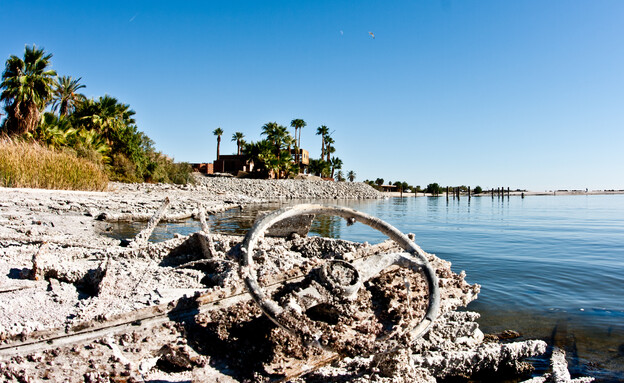The American Riviera
Early entrepreneurs saw the new development as an opportunity. Tent “cities” sprung up along the coastline offering basic accommodations for those seeking a taste of desert adventure. Fishermen flocked to the Salton Sea, their boats rocking on a sea surprisingly abundant with fish – the result of the intrusion of the fertile Colorado River. Stories of monstrous catfish and never-before-seen species lured fishermen, adding to the mystery of the new lake.
Publications in popular newspapers such as the Los Angeles Times and the San Francisco Chronicle fanned the flames of tourist interest. Articles pointed to the “healing waters” of Salton Lake – a claim with little scientific basis but a powerful attraction for the era’s health tourism seekers. Promotional materials described Salton Lake as a “sportsman’s paradise,” with promises of abundant hunting and fishing.
Soon the entire area became spectacularly beautiful, and began to attract real estate agents who wanted to develop Salton Lake and turn it into a French-style Riviera – including expensive yachts, summer homes, hotels and restaurants. 1.5 million vacationers came to Salton Lake in the 1950s and 1960s, including Some are as famous as the “Beach Boys” band.
The stinking rot of the Salton Lake
In 1970, heavy rainstorms destroyed the towns around the lake, causing more and more people to leave and the landscape to deteriorate. But that’s not all: over the years, a lack of oxygen supply in the water and the decomposition of plant parts by bacteria resulted in a very high level of hydrogen sulfide in Salton Lake, with tests showing that the average values sometimes exceeded the average by five times.
Over the years, much like our Dead Sea, the Salton Sea has shrunk and shrunk. Due to the evaporation of the water and the sediments that are exposed, the entire area emits a foul smell, mainly due to the hydrogen sulfide – a stench that can sometimes even be smelled in Los Angeles, which is about 240 kilometers away. The smell is not the only problem, since soil contaminated with metals including arsenic and pesticides have been washed into Salton over the years and now that the water has evaporated they are exposed to the open air. This has dramatic consequences for humans: the asthma rate among children living in the area around the lake is up to three times higher than in the rest of the United States.
Rescue plan – not a priority
To save the Salton Lake, the state of California has put together a 10-year restoration plan with more than $400 million in funding. The money is actually intended to be used to implement a plan that, among other things, will refresh the Salton Lake with almost a billion cubic meters of water from the Colorado River. But despite the good intentions, this plan was canceled, and now the flora and fauna that once thrived, continue to die and with them the entire area that is now classified as an ecological disaster.
But hope is not lost yet. As the NBC Palm Springs newspaper reports, the state of California still insists on saving the Salton Lake and its surroundings, and plans to implement a full restoration plan by 2028. In addition, other entities such as the environmental organization Audubon will also take additional restoration steps. However, the current slew of measures won’t help solve the bigger problem: the Salton Sea’s shoreline continues to recede, exposing more and more toxic soil.
The future of the Salton Lake is still uncertain. Restoration efforts are underway, with a focus on controlling dust emissions from the exposed lake bed. The Salton Lake serves as a reminder of the delicate balance between human intervention and the natural world. As we look towards its future, innovative solutions are needed to ensure that this artificial lake does not become an environmental wasteland and cause enormous damage to future generations.
